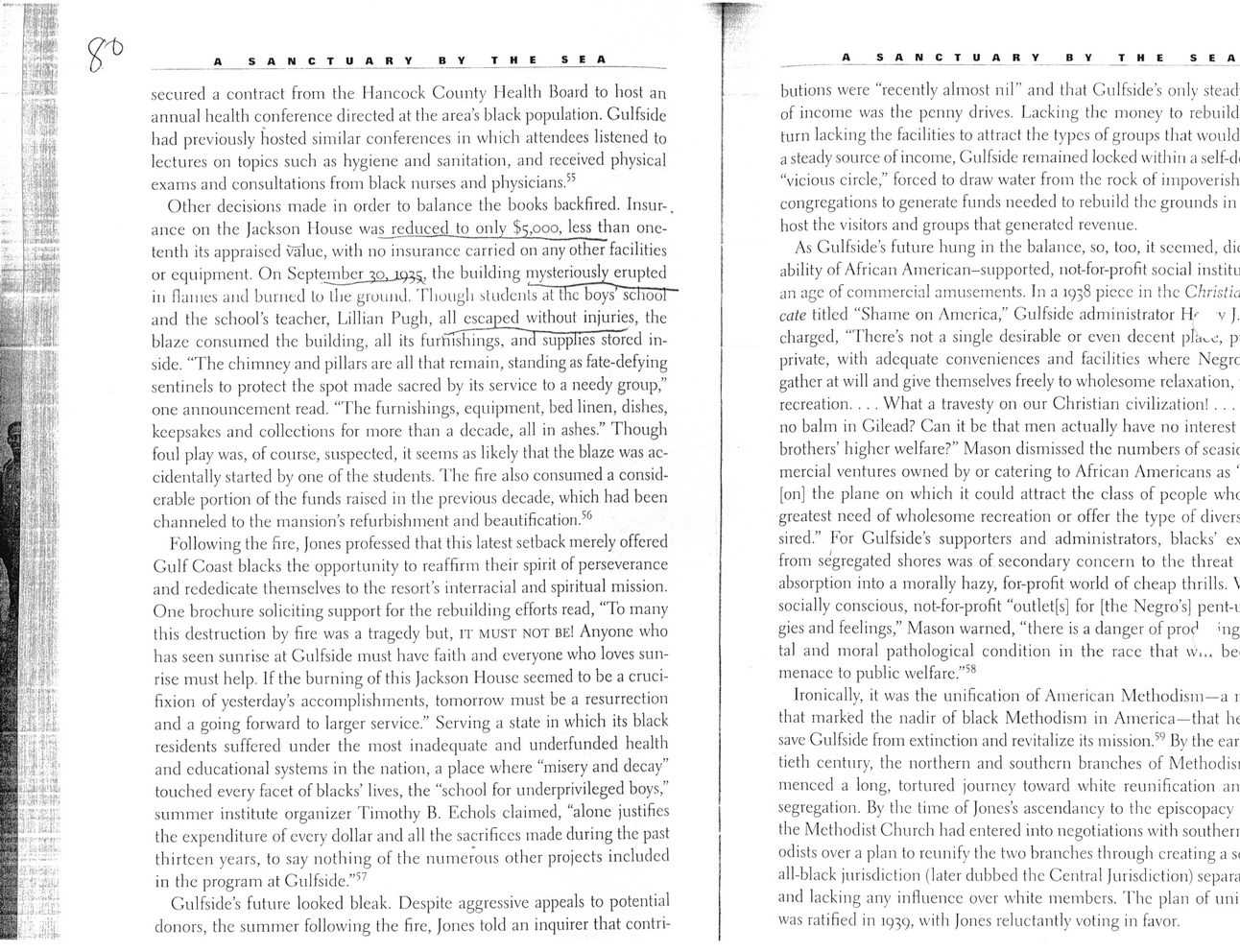This text was obtained via automated optical character recognition.
It has not been edited and may therefore contain several errors.
secured a contract from the Hancock County Health Board to host an annual health conference directed at the area’s black population. Gulfside had previously hosted similar conferences in which attendees listened to lectures on topics such as hygiene and sanitation, and received physical exams and consultations from black nurses and physicians.55 Other decisions made in order to balance the books backfired. Insur-, ance on the Jackson House was reduced to only $5,000, less than one-tenth its appraised value, with no insurance carried on any other facilities or equipment. On September 30. ims. the building mysteriously erupted in flames and burned to the ground. Though sliiclentsat the boysrscliool " and the school’s teacher, Lillian Pugh, all escaped without injuries, the blaze consumed the building, all its furhishings, and supplies stored inside. “The chimney and pillars are all that remain, standing as fate-defying sentinels to protect the spot made sacred by its service to a needy group,’’ one announcement read. “The furnishings, equipment, bed linen, dishes, keepsakes and collections for more than a decade, all in ashes.” Though foul play was, of course, suspected, it seems as likely that the blaze was accidentally started by one of the students. The fire also consumed a considerable portion of the funds raised in the previous decade, which had been channeled to the mansion’s refurbishment and beautification.56 Following the fire, Jones professed that this latest setback merely offered Gulf Coast blacks the opportunity to reaffirm their spirit of perseverance and rededicate themselves to the resort’s interracial and spiritual mission. One brochure soliciting support for the rebuilding efforts read, “To many this destruction by fire was a tragedy but, it must not be! Anyone who has seen sunrise at Gulfside must have faith and everyone who loves sunrise must help. If the burning of this Jackson House seemed to be a crucifixion of yesterday’s accomplishments, tomorrow must be a resurrection and a going forward to larger service.” Serving a state in which its black residents suffered under the most inadequate and underfunded health and educational systems in the nation, a place where “misery and decay” touched every facet of blacks’ lives, the “school for underprivileged boys,” summer institute organizer Timothy B. Echols claimed, “alone justifies the expenditure of every dollar and all the sacrifices made during the past thirteen years, to say nothing of the numerous other projects included in the program at Gulfside.”57 Gulfside’s future looked bleak. Despite aggressive appeals to potential donors, the summer following the fire, Jones told an inquirer that contri- A S A HI C T U ARY BV THE SEA butions were “recently almost nil” and that Gulfside’s only stead of income was the penny drives. Lacking the money to rebuild turn lacking the facilities to attract the types of groups that would a steady source of income, Gulfside remained locked within a self-di “vicious circle,” forced to draw water from the rock of impoverish congregations to generate funds needed to rebuild the grounds in host the visitors and groups that generated revenue. As Gulfside’s future hung in the balance, so, too, it seemed, die ability of African American-supported, not-for-profit social institn an age of commercial amusements. In a 1938 piece in the Christia cate titled “Shame on America,” Gulfside administrator H'_ v J. charged, “There’s not a single desirable or even decent pla«_e, p private, with adequate conveniences and facilities where Negrc gather at will and give themselves freely to wholesome relaxation, recreation. . . . What a travesty 011 our Christian civilization! . . . no balm in Gilead? Can it be that men actually have no interest brothers’ higher welfare?” Mason dismissed the numbers of scasic mercial ventures owned by or catering to African Americans as ‘ [on] the plane on which it could attract the class of people whc greatest need of wholesome recreation or offer the type of divers sired.” For Gulfside’s supporters and administrators, blacks’ ex from segregated shores was of secondary concern to the threat absorption into a morally hazy, for-profit world of cheap thrills. \ socially conscious, not-for-profit “outlet[s] for [the Negro’s] pent-r gies and feelings,” Mason warned, “there is a danger of prod mg tal and moral pathological condition in the race that w.,, be* menace to public welfare.”58 Ironically, it was the unification of American Methodism—a 1 that marked the nadir of black Methodism in Amcrica—that lit save Gulfside from extinction and revitalize its mission.59 By the ear tieth century, the northern and southern branches of Methodisi nienced a long, tortured journey toward white reunification an segregation. By the time of Jones’s ascendancy to the episcopacy the Methodist Church had entered into negotiations with southeri odists over a plan to reunify the two branches through creating a s< all-black jurisdiction (later dubbed the Central Jurisdiction) separa and lacking any influence over white members. The plan of uni was ratified in 1939, with Jones reluctantly voting in favor.

Gulfside Methodist Assembly Land-was-Ours---book-Kahrl-(12)